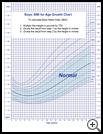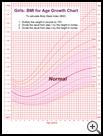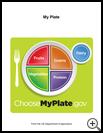
Weight Management: Teen Version
________________________________________________________________________
KEY POINTS
- The 3 keys to healthy weight management are making smart food choices, getting the most nutrition out of your calories, and balancing how much you eat with how much physical activity you do.
- Eat smaller servings. Drink water instead of energy drinks and soft drinks. Eat less fat and more fresh fruits and vegetables.
- Get some moderate to strenuous physical activity for 60 minutes each day.
- Avoid any diet that promises weight loss of more than 2 pounds per week, cuts out entire food groups, or does not suggest that you also need physical activity for health and weight loss.
________________________________________________________________________
What is a healthy weight?
Keeping a healthy weight is important to your health. Being at a healthy weight also increases your energy and self-confidence.
The weight that is right for you does not mean looking like people you see on TV, the Internet, or in magazines. The number you see on the scale doesn't necessarily tell you whether you need to lose weight. That's because 2 people of the same height and weight can have different bone structures and different amounts of muscle and body fat. Your healthcare provider can tell you if you have an increased risk of health problems because of your weight. Your provider can also help you find a weight-management program that works for you if you need one.
To find out if you are at a healthy weight, your healthcare provider usually checks your body mass index (BMI). BMI uses your height and weight to estimate how much fat you have. If your BMI for your age is in the overweight or obesity range on the growth chart, you are overweight or at risk for being overweight as an adult. If you are overweight, losing just 5 to 10% of your weight and keeping it off also lowers your risk for heart disease, stroke, diabetes, and some forms of cancer. Being underweight may be a sign of other health problems such as anorexia, inflammatory bowel disease, or gluten sensitivity.
The 3 keys to healthy weight management are:
- Make smart choices from every food group: fruits, vegetables, grains, milk products, meat or other protein-rich foods, and fats.
- Get the most nutrition out of your calories.
- Find a balance between how much food you eat and how much physical activity you do.
Physical activity is an important part of weight-management. If you are overweight, physical activity can help you reach a lower weight. Physical activity can also help you stay at a healthy weight.
What are some simple guidelines?
If you want to lose weight, you need a safe, healthy, well-balanced weight-loss diet. You also need to change your physical activity habits.
Use MyPlate as a way to eat a balance of healthy foods in the right amounts. Divide a 9-inch plate into portions for vegetables, grains and starches, and proteins. This helps you to choose foods for breakfast, lunch, and dinner. Fill half of the plate with nonstarchy vegetables. The other half of the plate should be split evenly. In one section, put starches including whole grains and starchy vegetables such as potatoes. The last section is for proteins such as lean meat, beans, lentils, tofu, and eggs. Fruit or a cup of low-fat or skim milk or yogurt on the side is OK.
Eat smaller servings.
Supersizing is so common that many of us don't even know what a healthy serving size should be. A good starting point is to cut your regular portions down by half. When eating out, take half your meal home. Order the small sizes or share the high-calorie items with a friend. Eat slowly, and you may be surprised to find that the smaller portions satisfy your hunger.
Cut back on saturated fat and trans fats.
Saturated fats are mainly in animal products such as whole and low-fat dairy products, lard, palm oil, and meats. Trans fats are made with a process called hydrogenation. It is done to keep fat from going bad and turns the fat from a liquid to a solid. These calories not only lead to weight gain, but they increase your risk for health problems such as heart disease. Common foods that are high in these fats include:
- Hamburgers, cheeseburgers, pizza, crispy chicken patties, chicken strips or nuggets, french fries, breakfast sandwiches with cheese, bacon or sausage, and deep-fried dessert pies
- Whole milk and whole milk desserts such as milkshakes and ice cream
- High fat lunch meats such as bologna, salami, and hot dogs
- Butter, sour cream, creamy salad dressing, full fat cheeses, heavy sauces, and baked goods
Take time to think about healthier versions of these favorites. You can:
- Make healthier homemade versions of fried foods. Use skinless chicken and bake meats instead of frying.
- Choose a grilled chicken sandwich, veggie burger, or grilled chicken salad instead of a hamburger or fried chicken.
- Order veggie pizza with half the cheese.
- Try skim milk desserts, low-fat yogurt, and reduced fat cheese.
- Eat low-fat or fat-free dressings.
- Use mustard instead of mayonnaise.
- Eat tomato-based sauces rather than cream sauces.
- Avoid bacon and sausage.
It helps to get your whole family involved. Keep lower fat versions of favorite foods in the house. Grill, bake, broil, steam, and stir-fry instead of frying.
Do not skip meals.
Get into the habit of eating 3 regular meals, keeping smaller portions in mind, and a few snacks in between meals. Skipping meals can make you hungrier and you may overeat later.
Snack on fresh fruits, vegetables, and low-fat or non-fat yogurt.
Fruit and vegetables help fill you up. Non-fat dairy products are high in calcium and protein and may help you stay at a healthy weight. Fresh fruit is a great snack. Try raw vegetables such as carrots, broccoli, cauliflower, and snap peas or prepare a small salad or bowl of low salt vegetable soup. Choose non-fat or low-fat yogurt or a small bowl of low-sugar cereal with low-fat milk and sliced fruit. Plan to take snacks with you so vending machine snacks and fast foods will be less tempting.
Have low-fat milk or water instead of a sugary drink.
A soda or soft-drink is just sugared water. It has about 250 calories per 20-ounce bottle and is one of the top causes of teen obesity. Energy drinks often have as much sugar and calories as soft drinks and more caffeine. Too much caffeine may be harmful to your health. It can also cause a fast or irregular heartbeat, stomach pain, anxiety, and trouble sleeping.
Try to get into the habit of drinking more water. It will keep you hydrated, quench your thirst, and fill you up. Carry bottled water with you and drink it throughout the day. You can recycle your water bottles or buy a reusable bottle. A quick way to check that you are getting enough water and other liquids is to look at the color of your urine. The urine should be pale yellow.
It is all right to drink something other than water. Non-fat and low-fat milk are a good choice. Fruit juices have many calories. Limit fruit juice to no more than 1 cup per day. It is better to eat whole fruit rather than drinking fruit juice. You can choose sugar-free drinks or no calorie fruit flavored drinks sweetened with NutraSweet, Stevia, or Splenda sometimes.
Do something physically active every day.
Get some moderate to strenuous physical activity for 60 minutes each day. It may take some time to get to this level of fitness, but it is a good goal. It is OK to start out slowly and work your way up. Include aerobic activity such as walking or swimming, strength building activities such as push-ups or lifting weights, and stretching activities.
Stay away from shortcuts.
Each year there are more diet plans, each promising great results. Some diets are very low calorie at less than 500 calories a day, or they include fasting. It is hard to tell which diets are based on good science and which are dangerous. Some diets limit you to a few specific foods. Generally, the only reason these diets work is because you are eating fewer calories. Results have little to do with the type of food you are eating. You can’t stay healthy if you follow these diets for too long. You may start having symptoms caused by a lack of some vitamins and minerals after just a few days on one of these diets.
Avoid any diet that promises weight loss of more than 2 pounds per week, cuts out entire food groups, or does not suggest that you also include physical activity for health and weight loss.
Using laxatives can take nutrients out of your system. Laxatives make you lose a lot of water, not fat, which can make you dehydrated.
Losing weight is hard work. If you go off your diet for one meal or one day, don’t let it affect the next day. It happens to everyone. Just get back on track. Remember that physical activity can lift your mood and keep you positive.
For more information, contact:
- USDA MyPlate
https://www.myplate.gov/
Last modified: 2021-12-07
Last reviewed: 2018-11-13



